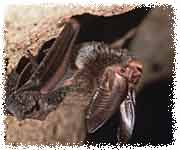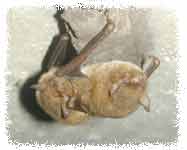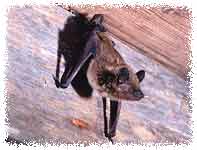| |
|
Information About Colonizing Florida Bats
As stated 18 separate species of bats have been sighted in Florida, although maybe only 13 are really resident species. Some of these are
rare as well. All bats have their own place in the environment, and are usually very beneficial in the elimination of insects, if you
happen to dislike insects. Most bats remain unseen, and the ones that are sighted are usually noted flying at dusk or dawn or around
street lamps. Bats are categorized into two types: bloodthirsty and non-bloodthirsty. Just kidding.
Solitary Roosting Bats: primarily use trees and vegetation to roost in, and live alone. Most people don't have any problems
with these bats, which can include such species as the Seminole Bat, the Hoary Bat, the Northern Yellow Bat, and of course the Eastern
Ret Bat of course.
Colonizing Bats: live in large groups, usually inside a large structure such as a cave or building. Sure, they could live inside
tree hollows if tree hollows were abundant, but they really seem to enjoy man-made structures such as the undersides of bridges, stadiums,
under tile roofs, barns, belfries, and most of all, in the attics of homes and other buildings. When it comes to pest control for bats,
these are the ones most commonly dealt with. These bats are described below:
 |
Ah, the Brazilian Free-Tailed Bat, also known as the Mexican Free-Tail, the most abundant mammal in the world. This is the bat
that I deal with at least 80% of the time. If you have bats living in your building and need bat pest control, they are almost
assuredly going to be Brazilian Free-Tailed bats. They are very well adapted for survival. They thrive in very hot temperatures, and
I've seen them living under tile roofs that must exceed 130 degrees. They often form huge colonies of several thousand members. To
identify this small bat, just look for the free tail sticking out from the membrane between the legs. Most bats don't have a tail.
|
 |
The Big Brown Bat is one of the most common bats dealt with throughout much of the United States. A lot of bat
control experts throughout the country deal with the Big Brown. Not me, though. They supposedly live in the northern half
of Florida, but I never see them. They are called Big Brown Bats because they are small and purple. No wait, big and brown. In
fact, the name may be to differentiate them from the most common bat up north, the Little Brown bat, also known as the Little Brown
Myotis. Like all colonizing bats, Big Browns think that attics are a swell place to set up shop.
|
 |
The Rafinesque's Big-eared Bat is very easy to identify on site. It is called the Big Eared Bat because it has regular
sized ears, but a very small nose, small eyes, small mouth, small neck, small body and small wings. The Rafinesque part of the name
came from the person who discovered this bat; Cletus Huckbuckle. This bat is a slow flyer, and although it roosts with other big-eared
bats, it will often rooste with Eastern Pipstrelles. No Western Pipstrelles though, the Rafinesque hates those west side pipstrelles.
|
 |
The Southeastern Myotis, like almost all bats, likes to live near water. Streams, rivers, lakes, ponds, and free-standing
outdoor toilets are all great water sources. Like almost all bats, it will eat all kinds of insects, such as moths, mosquitos, beetles, and
beatles. Although this bat isn't terribly common, Florida is host to the most SE Myotis in the world. They like to live in caves. Florida
has a couple of neat caves just loaded with these dainty flyers. Colonies can reach up to 100,000 members.
|
 |
The Evening Bat. is a little more common than some of the other fellows here. A pest control guy like me might run across
a few of these small bats from time to time. They like to form large groups inside buildings when they can't find space inside a
cypress tree. In fact, I think they prefer attics. A lot of people make a lot of big talk about how bats are losing habitat, and
while this is true for most of the species on this planet, I don't know about bats. It sure seems like our buildings give them a
better place to roost than they ever had in some crummy old tree.
|
Call 24/7 Wildlife Removal at 407-729-6946 to schedule a bat pest control appointment. If you have any of these species of
colonizing bats living in your building, you are at risk for diseases and sanitation problems. Bats are good animals, but they are not good house-mates. They
will frequently choose to roost in the attic of a house, and they will stay there, generation after generation, for hundreds of years if not excluded. They often
live inside commercial buildings, and hotels and condominiums. If you need a professional pest control company for bats in Florida, give me a call.

For more bat control information, go back to the Florida bat control page.
If you don't live in Florida, click here for the National Directory of Wildlife Trappers.
Here is a complete list of my bat pages:
Florida Bat Control
Bat Control in Orlando FL
How to Get Rid of Bats in the Attic or Roof
Pest Control for Bats
Bat Photograph Gallery 1
Bat Photograph Gallery 2
How to Kill Bats
Bat Repellent
SARS Transmission from Bats
How to Get Bats Out of the Attic
How to Trap Bats
Ultrasonic Sound Emitters for Bats
Florida Bat Control
Florida Bats
How to Get Rid of Bats
Orlando Bat Removal
Prices for Bat Removal
Tampa Bat Removal
How to Catch Bats
How to Keep Bats Away From Your House
| |
|